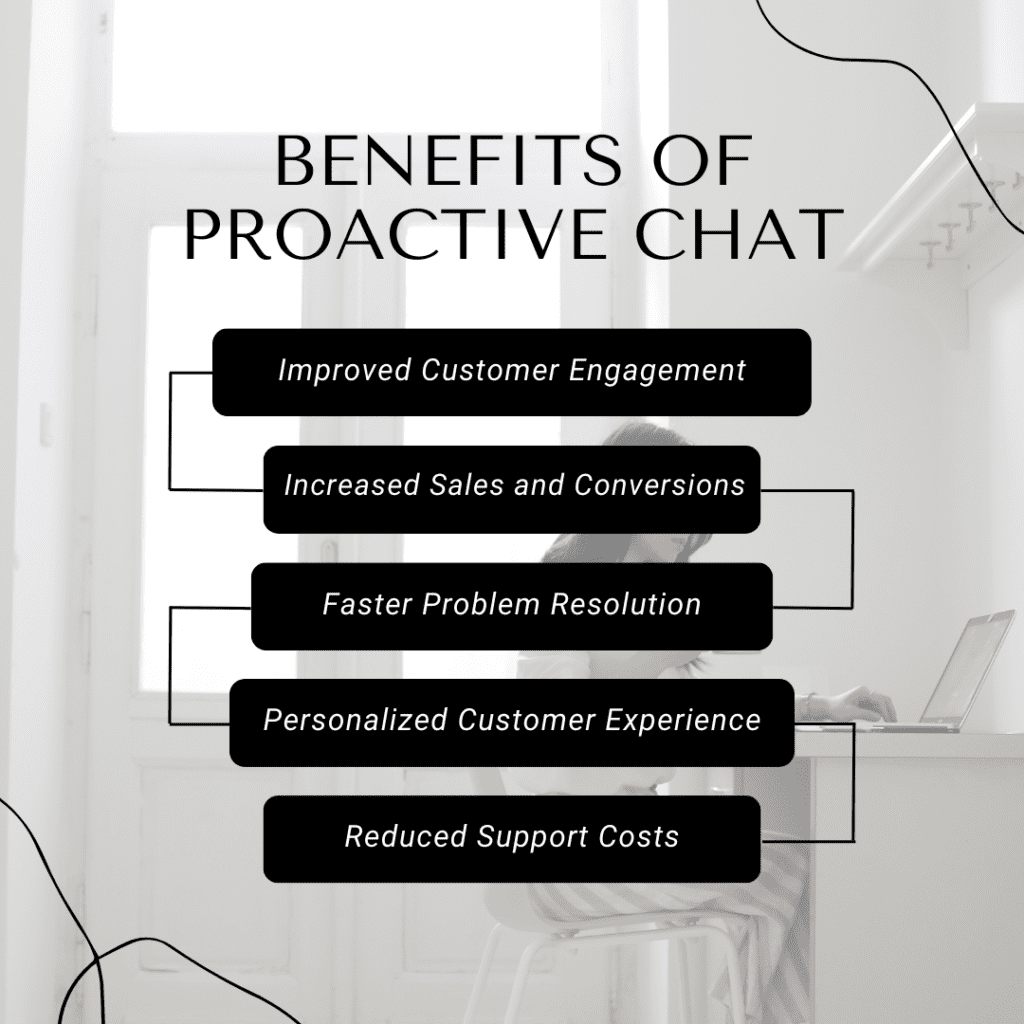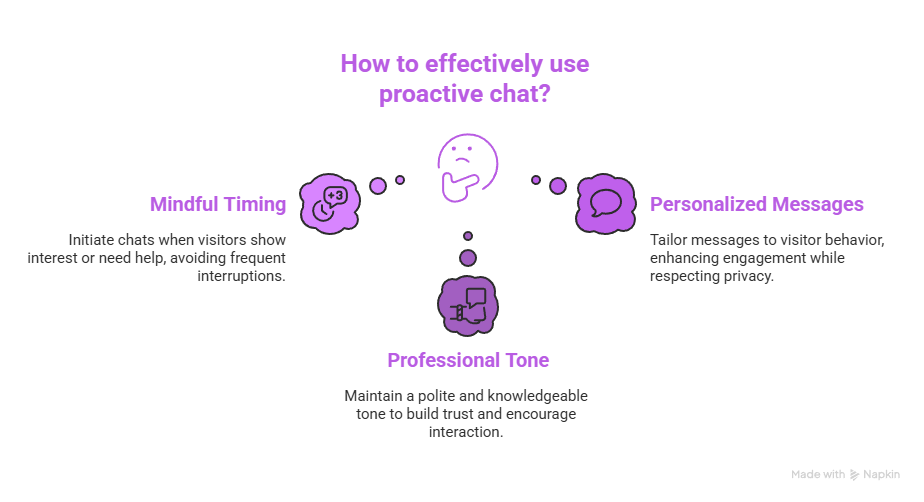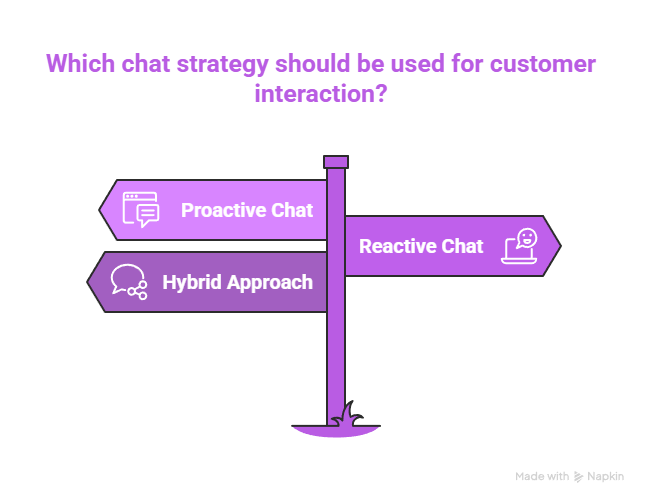Proactive Chat: Elevate Your Customer Experience Today!
02 Feb 2024 By: Michael Kansky
Updated

Proactive chat is one of the features of live chat services, which helps a business to start a conversation with visitors on their websites. Mainly, businesses use this to interact with customers, resolve queries, and offer support, resulting in a higher ratio of conversions.
It initiates response to certain behaviors such as the time a visitor spends on a page or a particular action they take on the website.
Proactive chat is an effective tool for businesses. It provides an opportunity to communicate with clients in real-time by offering instant replies. This article will cover everything you need to know about proactive chat – its benefits, principles of work, and best practices for using it.
What is Proactive Chat?
Proactive chat, as the name also indicates, refers to initiating a chat with a website visitor or via SMS. Rather than expect the visitor to ask a question or raise an issue, a window opens with a message from an agent. This message can be a greeting, an offer to assist, or a particular query about the activities of the visitor on the page.
Proactive chat typically reacts and automates with predefined sets of rules that define when and how to initiate a chat. Advanced solutions, such as those utilizing a p2p messaging service, can provide seamless communication by efficiently connecting users in real time. These rules can depend on various factors, including the visitor’s location, the page they are viewing, or the time spent on the site.
Automated Proactive Chat
Automated proactive chat is a feature that automatically starts conversations with visitors on your website, based on certain triggers like how long they’ve been on a page, what they’re looking at, or where they’re browsing from. For example, a chat might pop up if a visitor spends a few minutes on a product page or if they’re browsing from a specific location, offering help or answering questions.
This type of chat is really useful because it engages visitors at just the right moment, giving them a chance to ask for help when they might be feeling unsure or need more information. It helps businesses connect with potential customers, guiding them through decisions or providing support before they even have to ask.
That said, it’s important to use proactive chat carefully. If visitors get too many chat prompts or if the timing feels off, it can annoy them and make them leave. The key is finding the right balance—offering help without overwhelming the visitor. By setting smart rules for when and how chats are triggered, businesses can create a better customer experience, making visitors feel supported rather than pressured.
In the long run, businesses should regularly review and fine-tune their chat settings based on how visitors interact with the site. This helps ensure that the chat feature is effective, helpful, and doesn’t disrupt the browsing experience. When done right, automated proactive chat is a great way to improve customer service and boost sales without being intrusive.
Manual Proactive Chat
Manual proactive chat is when a live agent starts the conversation with visitors on your website, using their judgment to decide when to offer help. Unlike automated chat, where triggers are set by rules, this method allows a real person to assess the situation and jump in at just the right moment. Because it’s handled by a human, it can feel more personal and tailored to the visitor’s needs.
The big advantage of manual proactive chat is that it offers more flexibility. An agent can see if a visitor is spending a lot of time on a product page, checking out pricing details, or browsing FAQs, which might signal that they have questions. The agent can then send a message like, “Hi! It looks like you’re interested in our pricing—can I help answer any questions for you?” This kind of personalized interaction can make the customer feel appreciated and can lead to higher conversion rates.
However, manual proactive chat requires more effort and resources. It relies on live agents to monitor the site and start chats at the right time, which can be more expensive than using automated systems. Agents need to be quick and trained to recognize when a visitor might need help.
Manual proactive chat works best for businesses with lower website traffic, where an agent can easily manage conversations. In these cases, having a real person reach out can make a big difference. It’s especially effective for businesses that focus on personalized service, such as luxury brands or companies that handle complex products or services. A human touch can help build trust and make the experience feel more genuine.
Overall, while manual proactive chat costs more, it’s a great option for businesses that want to provide thoughtful, one-on-one customer support. For companies with fewer visitors or high-value products, this personalized approach can lead to better customer experiences and higher sales by engaging visitors in a meaningful way.
Benefits of Proactive Chat

Businesses can get several benefits from proactive chat. First, it adds to the effectiveness of the site by attracting potential customers and answer their concerns instantly. By being proactive, businesses help customers by providing immediate assistance and moving them closer to a sale.
Manual proactive chat has the most efficiency with companies that have low web traffic or complex products or services. This is where the personal attention and knowledge of a live agent will actually make a difference in the customer experience.
It also improves customer satisfaction by delivering a better level of service. It is a must for visitors who waits for an email response, and it takes things a step further by helping before the visitor ever has to type in what they need. This can help in creating a positive image of the business, and hence, increase the chances of repeated visits and referrals.
Increased Conversions
One of the main advantages of proactive chat is its ability to increase conversions. A business starts a chat with a visitor and engages them in a conversation, responds to all their queries and helps them in with their purchase. This can be very helpful for undecided visitors or people who may not have contacted us.
Find out how you can get more conversions and leads by using proactive chat!
It can also lessen cart abandonment by answering problems or issues at the check out level. One example where proactive chat triggers is when a visitor spends a long time on the checkout page, and asks the user if they have any questions. This will remove any problems or doubts that visitor may have and will stimulate him to complete his purchase.
Improved Customer Satisfaction
Another advantage of proactive chat is higher customer satisfaction. Through this, businesses can show their concern and dedication for their customers’ needs. This will help create a good impression and those people will possibly be returning visitors and refer other people.
In addition, proactive chat will provide quick help and speedy problem-solving, thereby improving customer experience. Live chat is popular among visitors because of its convenience and immediacy, but proactive chat is a level above; it offers help before a visitor even asks for it.
Below are reasons why live chat is preferred by many in 2024
Referring to a HubSpot survey, it stresses that more than 80% of buyers require the reaction time of their vendors to be below 10 minutes. Remarkably, the consumer satisfaction of the live chat is 92%, with over half of chats initiated from mobile devices.
This draws reader’s attention to the fact that user experience plays an important role in the success of apps, and it emphasizes the tendency to use in-app chat features. It covers many advantages including in-app customer support, polished user interface, enhanced marketing, higher conversion rates, decreased bad reviews, and dynamic outreach. The incorporation of live chat software boosts transactional support within the app by resulting in a seamless real time communication approach and a drastic decrease in response times compared to other channels such as emails.
Implementing Proactive Chat
Proactive chat implementation involves several steps. This process requires very detailed planning to make its features work well and give a good service.
The first thing to do is to choose a live chat service that provides this feature as well as complying with GDPR, HIPAA, and PCI. There are lots of choices, differing in their features and cost models. A company should think of what they need and how much they are willing to spend to make a call on this.
Setting Up the Chat Software
After selecting the live chat service, you need to install the chat software on the website. This typically involves adding some HTML code to the website. You should set up the chat software according to the website’s appearance to provide visitors with a seamless experience.
Learn more about live chat and the GDPR compliance.
In addition, the compatibility of the chat software with the platform and its ability not to reduce the performance of the site is also crucial. Some chat services provide plugins or integrations for website platforms that make the process of setup easier.
Defining the Rules for Initiating Chats
The next step in using proactive chat is deciding when and how to start conversations with your website visitors. The key is to set up clear rules to trigger the chat at the right time, offering help without being too pushy. These rules can be based on different things like what the visitor is doing on your site, where they’re located, or even the time of day.
For example, you can trigger a chat if a visitor spends a few minutes on a product page or if they’ve come to your site from a specific ad. You might also want to reach out to visitors from a certain country with location-specific offers or support.
When setting these rules, it’s important to make sure the chat starts at the right time and doesn’t overwhelm visitors with too many requests. The goal is to offer help when it’s needed without interrupting the visitor’s experience.
Factors to Consider:
High-Intent Pages: Pages like checkout or pricing are great places to offer support, as visitors may have questions before making a decision.
Visitor Behavior: Look at how visitors are interacting with your site. If they’re spending a lot of time on a page, it might be the perfect time to offer help.
Time on Site: If someone has been browsing for a while but hasn’t made a move, a friendly chat can encourage them to take the next step.
Location: If your business offers region-specific services or promotions, you can trigger chats based on where the visitor is located.
Returning Visitors: If a visitor has been to your site before but didn’t take action, a proactive chat can re-engage them when they return.
Training Staff or Setting Up Automated Responses
Train the staff to respond to proactive chats or with automated responses. In case live agents will take care of the chats, be sure to train them how to open a chat, answer questions, and initiate a conversation.
If automated replies are to be used, they should be programmed to offer useful and appropriate answers. Answers must be written in a friendly and professional style to make sure that they work properly and create a good visitor experience.
Proactive Chat Examples
1. Helping Customers Ready to Buy
A customer is taking time at the checkout page. A proactive chat pops up:
“Hi there! Need help finishing your order? I’m here if you have any questions.”
This gives the customer a friendly nudge and prevents them from leaving without buying.
2. Offering Product Help
A visitor is browsing a product page for a while. A chat message appears:
“Hey! Do you need more info about this product? I’m happy to help!”
This helps the visitor feel supported and can move them closer to making a purchase.
3. Assistance with Forms
Someone is filling out a sign-up form but pauses. A helpful chat appears:
“Hi! Need a hand finishing your sign-up? I’m here if you have any questions!”
This makes the process easier and reduces the chances of someone abandoning the form.
4. Welcoming New Visitors
A new visitor lands on your website. After a few moments, a friendly chat appears:
“Welcome! If you need help finding anything or have questions, just let me know!”
This makes the visitor feel welcome and comfortable asking for assistance.
5. Offering Discounts
A customer is browsing but hasn’t taken action yet. A chat message appears with a special offer:
“Hi! Thanks for visiting. Here’s a 10% discount just for you! Need help applying it?”
This proactive chat adds a personal touch and encourages the customer to make a purchase.
These examples focus on making the experience feel personal, friendly, and helpful, encouraging customers to engage with your business.
Best Practices for Proactive Chat

Although proactive chat is useful for businesses, it should be used carefully so visitors won’t feel overwhelmed. The following is the list of best practices for making use of proactive chat effectively.
First, the business needs to actively decide on the use of proactive chats. They can trigger chat at certain points, e.g. when the visitor is on the product page of when they are about to leave the site. But it is important for the businesses not to start the chat too often, as this will interfere and irritate the visitors.
Mindful Timing
Timing is one of the principal aspects of successful proactive chat. Chats should be started when a visitor is more likely to need help or when there is a sign of interest in a product or service. It could be initiated after a visitor spends a certain duration on a product page or after adding an item to the cart.
Nevertheless, too frequent and too soon chat initiations should be avoided as well. This is disruptive and annoying, and it may also make the visitor feel stressed or troubled. Companies should monitor the performance of proactive chat timing and modify it when necessary to make the feature work at its best.
Personalized Messages
Another best practice is to personalize messages. Rather than having general greetings or offers of help. Firms should personalize their messages to the behavior or condition of the visitor. For instance, if a first-time visitor is looking at a product, the operator can provide details about the product and answer some questions.
Personalized messages make the visitors feel understood and will help the feature to work effectively. Though personalization should be used with caution and the visitor’s privacy should be kept in mind. Businesses should should adhere to all the privacy laws and regulations applicable.
Professional and Friendly Tone
Last but not least, proactive chat messages should be written in a polite and business-like manner. The style of the message can strongly influence the visitors’ attitude towards the company and their desire to start chatting.
A professional tone shows knowledge and reliability, while a friendly tone makes the visitor feel at home and respected. The message should also be straightforward and to the point, so the visitor gets the offer of help and feels urged to reply.
Proactive Vs. Reactive Chat

Proactive vs. Reactive Chat: What’s the Difference?
Live chat is a powerful tool for connecting with customers, but there are two main ways to use it: proactive chat and reactive chat. Each has its own style and benefits, depending on how you want to interact with visitors. Let’s break it down.
Proactive Chat
Proactive chat is when you start the conversation with visitors before they ask for help. It’s like a friendly greeting in a store when someone looks like they might need assistance. You can set it to pop up based on certain triggers, like how long a person spends on a page or what they’re looking at.
Benefits of Proactive Chat:
- Keeps Visitors Engaged: Starting a chat can make visitors feel noticed and appreciated, keeping them interested instead of leaving the site.
- Boosts Sales: Offering help at just the right time—like during checkout—can clear up any questions and encourage customers to make a purchase.
- Answers Questions Early: If a visitor is unsure about something, a proactive chat can clear up confusion before they even have to ask, reducing frustration.
- Makes It Personal: You can tailor the chat to the person’s behavior on your site, making them feel like you’re speaking directly to their needs.
- Solves Problems Before They Happen: Sometimes, customers don’t realize they need help until you offer it. Proactive chat lets you step in before they get stuck or leave.
Example:
A visitor is browsing a product page for a few minutes. A friendly chat message pops up:
“Hi! Do you need help with this product? I’m here if you have any questions.”
Reactive Chat
Reactive chat is more traditional—here, the customer starts the conversation. It’s like when a shopper approaches you in a store to ask for help. The chat box is available for them to click on whenever they need assistance.
Benefits of Reactive Chat:
- Customer Leads the Way: The customer decides when to start the conversation, so they feel in control and won’t feel overwhelmed by a sudden chat popping up.
- Non-Intrusive: Since they initiate the chat, it’s less likely to feel like you’re pushing them. It’s there when they need it, and that’s comforting.
- Great for Detailed Questions: Reactive chat works well for customers who have specific or complicated questions they want to ask when they’re ready.
- Easier to Manage: Because customers are starting the chat, you’re only responding to those who actively need help, making it easier for your team to handle the workload.
Example:
A visitor has a question about a service you offer. They click on the chat and ask:
“Can you explain how your pricing works?”
Which Is Better: Proactive or Reactive Chat?
It depends on what you’re looking to achieve.
- Proactive chat is great if you want to encourage more engagement, prevent drop-offs, and increase sales. It’s especially useful in online stores where you can help customers in real time and answer questions about products or services.
- Reactive chat works well for businesses with more complex products or services, or for visitors who prefer to reach out only when they need something specific.
Why Not Use Both?
For many businesses, a mix of proactive and reactive chat works best. You can start conversations with visitors who seem to need help, while still offering the option for customers to reach out when they’re ready. This way, you’re available no matter how your visitors prefer to engage.
Conclusion
Proactive chat is one of the powerful tools that is used to engage website visitors, provide immediate help as well as the conversions. Nevertheless, the tool needs to be used wisely to make sure that it brings a proactive customer approach,
“The best chats are those you initiate. Proactive chat will help you start significant communication with your online visitors.”
Understanding the parts of proactive chat helps businesses improve their service. Regardless of whether a business uses automated or manual proactive chat, the most important thing is to be able to provide a great customer experience


